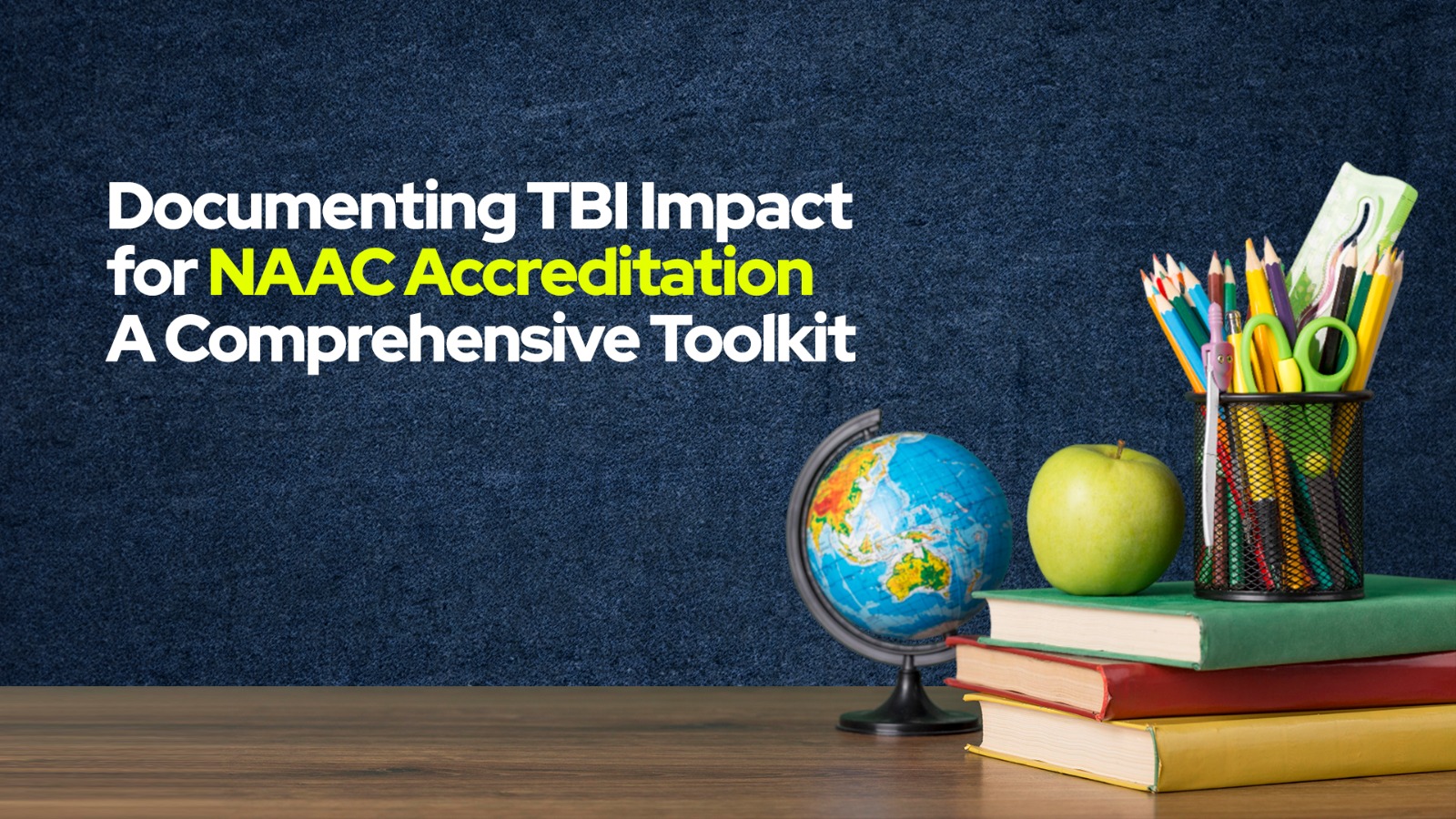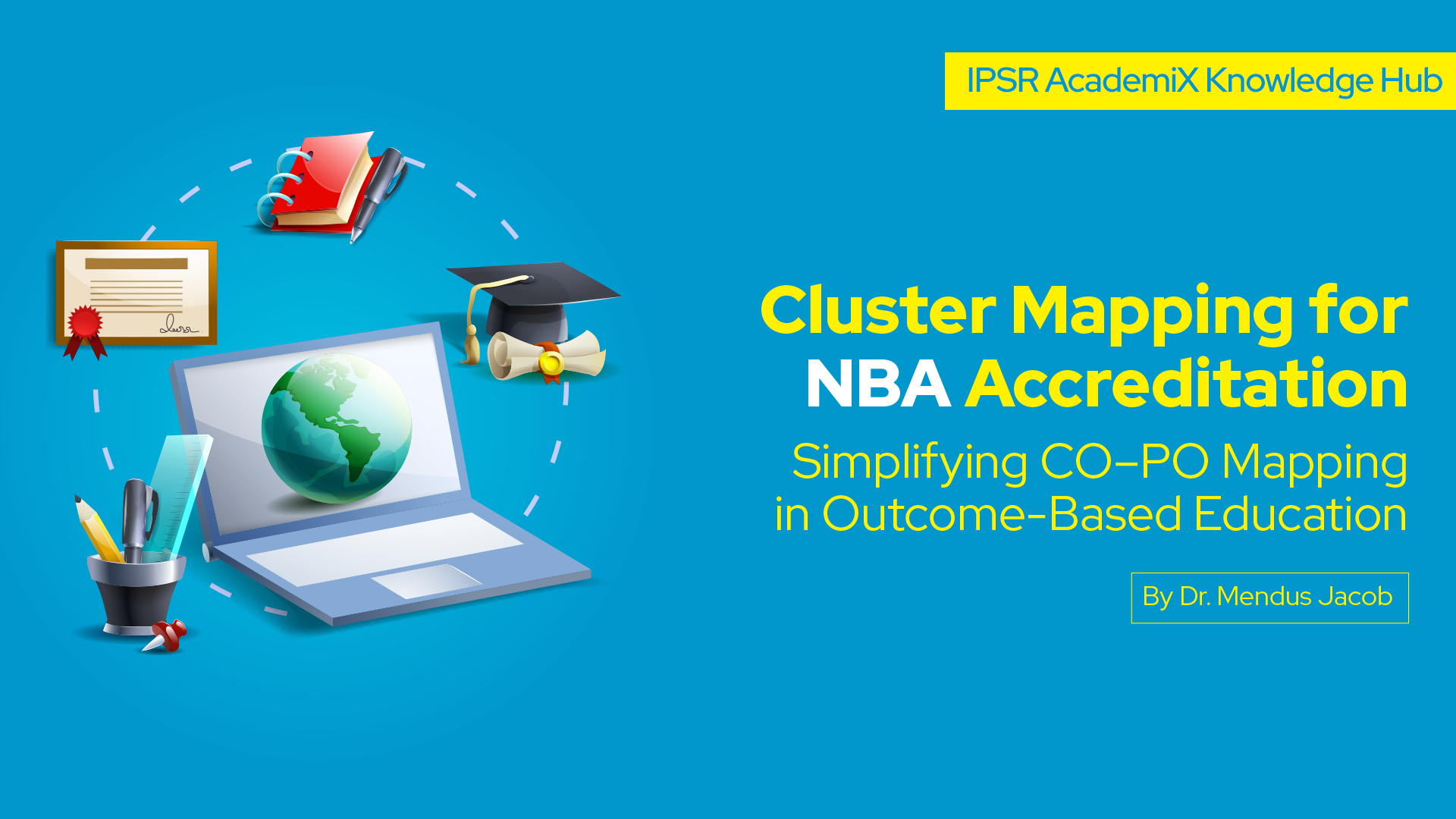
As institutions across India strive for NAAC accreditation and pursue excellence in quality benchmarks, the focus is shifting from activities to impact. It’s no longer enough to highlight that initiatives were conducted—what matters is how they transformed learners, institutions, and society.
One of the most powerful platforms for showcasing institutional impact is the Technology Business Incubator (TBI). A well-functioning TBI can serve as a cornerstone for demonstrating real innovation ecosystems, tangible research outcomes, measurable student progression, and meaningful community engagement—all key focus areas under NAAC.
This article outlines a structured approach to mapping TBI activities to NAAC criteria, with an emphasis on documenting outcomes and impact, rather than mere outputs. It also offers practical templates and formats to ensure your data is audit-ready and impact-focused.
This comprehensive toolkit covers:
NAAC Criteria Mapping for TBI Activities
Criterion III (Research, Innovations & Extension) – Innovation Ecosystem: Map TBI activities to NAAC’s key indicator on innovation. NAAC expects institutions to have an ecosystem for innovation (e.g. entrepreneurship cell, incubation centre, IPR facilitation) and to show evidence of its outcomes. Document how the TBI fulfills this by supporting startups, facilitating patent filing, and transferring knowledge. This directly addresses the indicator “Institution has created an ecosystem for innovations including Incubation centre and other initiatives for creation and transfer of knowledge.”
Criterion III – IPR & Entrepreneurship Initiatives: Highlight TBI-led programs under NAAC metrics for workshops/seminars on Intellectual Property Rights (IPR), entrepreneurship, and research methodology. NAAC specifically measures the “Number of workshops/seminars conducted on IPR and industry–academia innovative practices during the last five years”. Include details of any startup bootcamps, business plan competitions, hackathons, or IPR workshops run via the incubator as evidence.
Criterion III – Collaborations (MoUs/Linkages): Leverage the TBI’s industry and academic linkages to address NAAC indicators on collaborations. NAAC looks at “number of functional MoUs/linkages with institutions/industries… for internships, on-the-job training, projects, student/faculty exchange, and research”. List the MoUs the incubator has with industries, innovation councils, investors, or entrepreneurship networks. For each linkage, note how it benefits students/faculty (e.g. internship opportunities at startups, joint research, funding support for incubated companies).
Criterion III – Research & IPR Outcomes: Use the incubator’s output to bolster evidence in research and innovation metrics. While NAAC doesn’t have a standalone quantitative metric for patents or startups, these can be cited in the qualitative narrative. For instance, patents filed or commercial products launched through TBI support can be mentioned as outcomes of the innovation ecosystem. Similarly, any research grants or prototypes stemming from TBI projects can support Research criteria (e.g. under innovation outcomes or resource mobilization for research).
Criterion V (Student Progression) – Entrepreneurship as Outcome: In Student Support & Progression criteria, showcase entrepreneurship as a form of student progression. If the NAAC framework allows, include data on students who became entrepreneurs (startups launched by recent graduates) as part of placement/self-employment statistics. This emphasizes how the TBI contributes to students’ career outcomes (e.g. X% of students opt for entrepreneurship with incubator’s support).
Criterion VII (Best Practices & Institutional Distinctiveness): Present the TBI as a best practice if it’s a unique strength of the college. NAAC’s Criterion VII allows highlighting two best practices – you can frame the incubator’s functioning (objectives, process, impact) as a Best Practice showcasing innovation culture. Emphasize aspects like fostering entrepreneurship in rural/technical domains, or the TBI’s role in socio-economic development (linking to NAAC’s “Institutional Values & Social Responsibilities”). Additionally, in the Institutional Distinctiveness section, mention how the incubator sets the college apart (for example, “the only college in the region with a thriving incubation center supporting startups and patents”). This narrative should connect the TBI’s impact to the institution’s vision and quality goals.
Measurable Impact Areas of the Incubator
showcasing the contributions of TBIs in a manner that aligns with NAAC accreditation requirements demands thoughtful structuring and accurate documentation. This guide serves as a practical toolkit for higher education institutions looking to quantify and present the impact of their incubation centres as credible evidence under various NAAC criteria.
Number of Startups Incubated: The count of startups nurtured in the TBI is a primary impact metric. Track how many startups have been incubated each year, along with their founders’ affiliation (students, faculty, or alumni). This shows the volume of entrepreneurial activity. Also note how many startups have graduated from the incubator or are still in incubation. (NAAC reviewers will see this as a direct outcome of the innovation ecosystem.)
Patents and Intellectual Property: Record the number of patents filed or granted as a result of incubator support. Patents (or copyrights, designs, etc.) indicate innovation output. For each patent, note the title, inventors (student/faculty startup teams), and date. Even patent applications or IPR awareness among incubated teams can be highlighted to show a culture of innovation and respect for intellectual property.
Products & Prototypes Developed: Beyond formal IPR, list notable prototypes, products, or technologies developed by incubated ventures. This could include working prototypes built in the campus TBI lab, apps or software launched, or any technology transfer to industry. Such outcomes demonstrate knowledge transfer and real-world impact of research/innovation activities.
Revenue Generated and Funding Attracted: Document the economic outcomes of incubation – for example, total revenue generated by all incubated startups, and external funding or investment they have secured. This could include seed funding from grants (government innovation grants, startup India funds) and venture capital or angel investment raised by startups. A strong showing in funding raised by incubatees underscores the incubator’s effectiveness. Similarly, revenue and profit figures (where applicable) for startups demonstrate market traction. These financial metrics, along with jobs created, highlight broader economic contributions of the incubator to the region (an aspect NAAC may appreciate under community development or extension).
Student & Faculty Engagement: Measure how many students and faculty are actively involved in the TBI’s initiatives. This includes the number of student entrepreneurs (students who have started or are part of startup teams) and faculty entrepreneurs or mentors (faculty who launched startups or mentored teams). Also count student internships or project work facilitated through the incubator (e.g. students interning with the incubated startups or doing capstone projects linked to TBI). High engagement numbers show that the incubator is integrated into academic and co-curricular activities, contributing to experiential learning.
Internships and Jobs Created: Track the internship opportunities and employment generated. For instance, note how many students got internships or part-time roles in the startups, and how many full-time jobs were created by these new ventures for graduates or the local community. Job creation is a key impact of incubators – it demonstrates social and economic relevance. NAAC’s focus on extension could be partly addressed by showing that startups are solving real problems and providing employment (a community impact).
Mentoring and Coaching Hours: Quantify the support provided through the incubator in terms of mentorship. Record the number of mentoring sessions or hours of expert consultation delivered to startups (by faculty, industry mentors, or alumni). Also count entrepreneurship training programs conducted (such as workshops on business model development, pitching, financial literacy for startups). These numbers reflect the input efforts and the supportive ecosystem for innovation.
Workshops, Events, and Competitions: Count all innovation-related events organized via the TBI: IPR workshops, startup bootcamps, hackathons, entrepreneurship talks, demo days, innovation contests, etc. For NAAC, you’ll specifically want the five-year tally of relevant seminars/workshops. Note the number of events, topics, dates, and participation (how many students/faculty attended). This showcases the vibrancy of the innovation culture on campus.
MoUs and Partnerships: Keep a tally of MoUs, partnerships, or linkages that the incubator has facilitated. This can include agreements with industry partners, other incubators or accelerators, knowledge partners, angel investor networks, or government bodies (like MSME, startup cells). Each MoU can be an indicator of the network strength of the TBI and provides avenues for student/faculty exchange, funding, and training – all of which align with NAAC collaboration metrics.
Awards and Recognitions: List any awards, recognitions, or accolades received by the TBI or its incubated startups. For example, if startups won innovation contests at state/national level, or if the incubator itself is recognized (e.g., as a nodal center by agencies like DST, or earned an excellent rating in innovation rankings), these achievements should be documented. Such recognitions reinforce the quality and impact of the incubator’s activities in the eyes of NAAC evaluators.
(Each of these impact areas should be backed by evidence – documents, certificates, reports, or data – which will be collected in the templates described next.)
Data Collection Templates and Formats
Startup Portfolio Table: Maintain a master list of all startups incubated through the TBI, in a tabular format for clarity. Include key details such as Startup Name, Founders (with designation as student/faculty/alumni), Year of incubation/start, Sector/Industry, Current Status (ongoing, graduated, or exited), and Notable Achievements. Notable achievements can note if the startup received funding (with amount), filed patents, won awards, or generated revenue. This table provides a snapshot of the incubator’s output and can be broken down year-wise to show growth. (This could be presented as a table in the SSR Appendix – ensuring each startup entry has supporting documents like incorporation certificates, etc., if needed.)
Innovation Activity Log: Use a tabulated log or spreadsheet to record all innovation-related events and activities facilitated by the TBI. For each event, capture Date, Title/Topic, Type of Event (workshop, seminar, competition, training), Key Organizer/Resource Person, and Number of Participants. You might also include a column for Outcome/Remarks (e.g., “5 prototypes developed in hackathon” or “IPR workshop led to 10 patent idea disclosures”). Such a log ensures you have structured evidence of workshops/seminars to satisfy NAAC’s quantitative metrics, and it can be summarized in the SSR with reference to detailed reports.
Mentorship and Expert Sessions Record: Create a template to track mentorship engagements. This can be a simple table listing Mentor/Expert Name, Affiliation/Expertise, Session Date(s), Topic or Area of Advice, and Hours of Mentoring. It’s useful to note whether the mentor is internal (faculty) or external (industry/alumni). Summarizing “Total mentoring hours provided through TBI” over each year gives a clear metric for the support system available to startups. (Each entry can have an associated proof like mentor visit reports or session feedback forms if needed for evidence.)
Patent and IPR Register: Maintain a register or table for all patents and other IPR outputs linked to the incubator. Columns should include Patent Title/Description, Inventor(s) Name (and whether student/faculty), Application Number, Status (filed/published/granted), and Year. Include similar entries for copyrights or designs if applicable. This structured data will support any claims of innovation output in the SSR. If no patents yet, record any IPR filings in process or IPR workshops outcomes (like number of patent searches or disclosures) to show progress.
MoUs/Partnerships List: Use a tabular format to list all relevant MoUs and collaborations. Columns could be Name of Partner Organization, Purpose of MoU (e.g., startup funding, mentorship, joint research, internship placements), Date of Signing, Duration, and Outcomes So Far. For outcomes, mention briefly what the MoU has yielded – e.g., “Internship for 3 students at XYZ Startup via this MoU” or “Joint organization of 2 hackathons”. This will help address NAAC’s requirement to show active linkages, not just signed documents. In the SSR, you can refer to this list and include copies of a few significant MoUs as evidence.
Financial and Outcome Summary: Prepare a year-wise summary table of key TBI impact metrics to include in the SSR narrative or annexures. For each year (or each academic year), list metrics such as No. of startups incubated that year, Cumulative startups to date, Funding raised by startups (₹), Revenue of startups (₹), No. of new jobs created, No. of events conducted, and No. of patents filed. This provides a quick-reference dashboard of the incubator’s performance over the accreditation period. NAAC evaluators find such summaries useful for grasping trends (e.g., a steady increase in startups or funding indicates improvement in innovation culture). Ensure that each figure in the summary can be traced back to detailed records (like those mentioned above) if verification is needed.
Evidence Portfolio: Alongside data tables, compile a portfolio of evidence documents neatly labeled to correspond to each metric. For example: minutes of TBI committee meetings, photographs of events, brochures of seminars, certificate copies of awards, patent filing receipts, startup registration documents, news articles featuring your startups, etc. Organize them by criterion or by theme. While not a “format” per se, having a well-organized repository (physical or digital) ensures that when NAAC asks for specific proof (through DVV clarifications or during the visit), you can quickly provide it. A suggested approach is to keep a mapping document that links each NAAC sub-criterion to the relevant TBI documents (for instance, Criterion 3.2.1 – Innovation Ecosystem: see Annexure 3.2.1(a) for list of startups, 3.2.1(b) for incubation policy, 3.2.1(c) for startup success stories, etc.). This way, data collection is structured and retrieval is easy.
Narrative Framing for SSR and Presentations
Align with NAAC’s Language and Criteria: Frame the write-up in the Self-Study Report (SSR) using the keywords from NAAC’s criteria to make mapping explicit. For example, in the SSR narrative for Innovation Ecosystem, explicitly state: “The institution has established a robust innovation ecosystem through its Technical Business Incubator, aligning with NAAC Criterion III. This ecosystem includes an Incubation Centre and an IPR cell that facilitate creation and transfer of knowledge.” By echoing NAAC’s criterion wording, you assure evaluators that you are addressing the required indicators directly.
Start with Quantitative Highlights: Begin the narrative or presentation section on the TBI with impressive key figures to grab attention. For instance: “In the last five years, our TBI incubated 25 startups, facilitated 8 patent filings, and helped student entrepreneurs secure ₹2 Crore in external funding.” Such a snapshot primes the NAAC team to recognize tangible outcomes. Follow this up by stating how these outcomes fulfill NAAC criteria (e.g., innovation ecosystem yielding patents and startups, collaborations yielding funding).
Use Case Studies and Success Stories: Augment data with one or two brief anecdotes that humanize the impact. NAAC peer teams often appreciate qualitative narratives that show how the numbers translate into real impact. For example, describe “Startup X (founded by our alumni through the TBI) developed a product that won a national innovation award and is now providing jobs to 20 local youth.” This ties into extension and community development themes as well. In the SSR, this can be woven into the outcome of the incubation ecosystem. In presentations, consider a slide with a success story (including visuals if available) to make the impact memorable.
Demonstrate Structured Support and Processes: In your write-up, highlight the institutional support mechanisms for the TBI – e.g., policies, infrastructure, funding, and administrative backing. Mention that the college has an entrepreneurship development policy or has allocated seed-fund grants to startups (if applicable), and that there’s a governing committee for the incubator. This shows NAAC evaluators that the TBI isn’t an ad-hoc activity but a well-integrated part of the institution’s research and innovation strategy. You can say, for instance: “The Incubation Centre operates with a defined policy (available on our website) and dedicated space of 5,000 sq.ft., equipped with labs and co-working facilities, demonstrating our commitment to fostering innovation.” Such details reinforce Criterion III’s focus on research infrastructure and ecosystem.
Emphasize Outcomes and Improvements: Ensure the narrative is outcome-focused rather than just descriptive. NAAC is outcome-oriented, so for each aspect of the TBI, state the impact or improvement it led to. Instead of simply listing activities (“TBI conducted three workshops on startup finance”), add the result or benefit (“…resulting in 15 student teams developing business models, out of which 5 progressed into full startups”). If you have comparative data (e.g., zero startups before TBI vs. 25 now), mention the growth to show quality enhancement over time. This aligns with NAAC’s ethos of continuous improvement.
Cross-Reference Evidence in SSR: While narrating in the SSR, reference the data tables and documents you have prepared. For example: “(Details of all incubated startups are provided in Table 3.2.1 in Annexure, showing year-wise growth of our innovation ecosystem).” or “(See MoU List in Annexure 3.5.1 for partnerships facilitating these startups).” This makes your documentation credible and easy to verify. During the NAAC visit, you can quickly show these referenced documents. In a presentation, you might not show every table, but you should be ready to produce them if asked.
Visual Aids for Presentations: When presenting to the NAAC team (or in any PPT during their visit), use clear visuals to complement the narrative. Consider charts or infographics: for instance, a bar graph of the number of startups each year, a pie chart of sectors of startups, or a flowchart of the incubation process (from idea submission to incubation to graduation). Photos are powerful too – include a slide with photos of the incubation center in action (students at work, mentors visiting, product prototypes, etc.). Ensure each visual has a caption relating it to a NAAC criterion (e.g., “Figure: Students working on startup prototypes in the TBI lab – exemplifying our innovation ecosystem (Criterion III)”). This reinforces the message and makes it easier for the NAAC peer team to connect what they see with the criteria they evaluate.
Highlight Institutional Vision and Societal Impact: Frame the existence and success of the TBI in the context of the college’s mission and societal responsibilities. For example, if the college’s vision mentions entrepreneurship or regional development, state that “the TBI is a key driver in realizing our institutional vision by promoting entrepreneurial mindsets and contributing to local economic growth.” Connect startup outcomes to societal benefits (employment, solutions to local problems, technology commercialization for public good) to also touch upon extension and community impact, which NAAC values under Criterion III and VII. This narrative angle shows that the incubator is not just for business, but for broader institutional and societal goals.
Prepare for Questions and Clarifications: NAAC assessors may ask questions to clarify the TBI’s functioning. Be ready with concise answers and examples: How do you select startups? What seed funding or support is provided? Can you show us this startup’s product? Make sure your team (faculty in charge of TBI, student entrepreneurs) are on the same page with key points. Including a short SOP or process document in the SSR (or as additional information) about “How the Incubation Center operates” can be useful. It provides narrative on governance, selection process, mentorship process, etc., which can pre-empt questions.
Consistency and Honesty: Finally, ensure that the narrative is consistent with the data. All quantitative claims in your write-up should match the numbers in your tables and evidence. Avoid any exaggeration; NAAC teams often verify random entries. If a particular startup is highlighted as a success, ensure that NAAC can, if they choose, interact with the people involved or see the product. Honesty and clarity in documentation build trust – if something is in progress (e.g., patents filed but not yet granted), state it transparently. NAAC appreciates a reflective tone where institutions acknowledge challenges and plan improvements (you might note, for instance, “Going forward, the TBI aims to increase faculty-led startups and seek more industry-funded projects to enhance its impact further.”). This shows a mature and quality-focused approach to running the incubator.
By following this structured approach – mapping TBI outcomes to NAAC criteria, gathering metrics in organized templates, and crafting a clear narrative – an institution can effectively showcase the impact of its Technical Business Incubator. This toolkit serves as a starting point, helping institutions present their innovation achievements confidently and coherently to the NAAC accreditation team. Every statistic and story about the TBI can then reinforce the institution’s commitment to research, innovation, and extension, thereby meeting and exceeding NAAC’s expectations.
Join us for FREE to get instant email updates!

Simplifying CO–PO Mapping in Outcome-Based Education Accreditation by the National […]

The National Institutional Ranking Framework (NIRF) 2025 results are out, […]

What the Top 100 Rankings Reveal About India’s Universities The […]

Exploring patterns, trends, and the evolving landscape of technical education […]

Release date: September 4, 2025 Source: NIRF portal’s Overall Top-100 […]

“Mastering OBE: OBE Strategies and Implementation of deQ OBE for […]

The National Institutional Ranking Framework (NIRF) 2025 has unveiled its […]
Leave A Comment